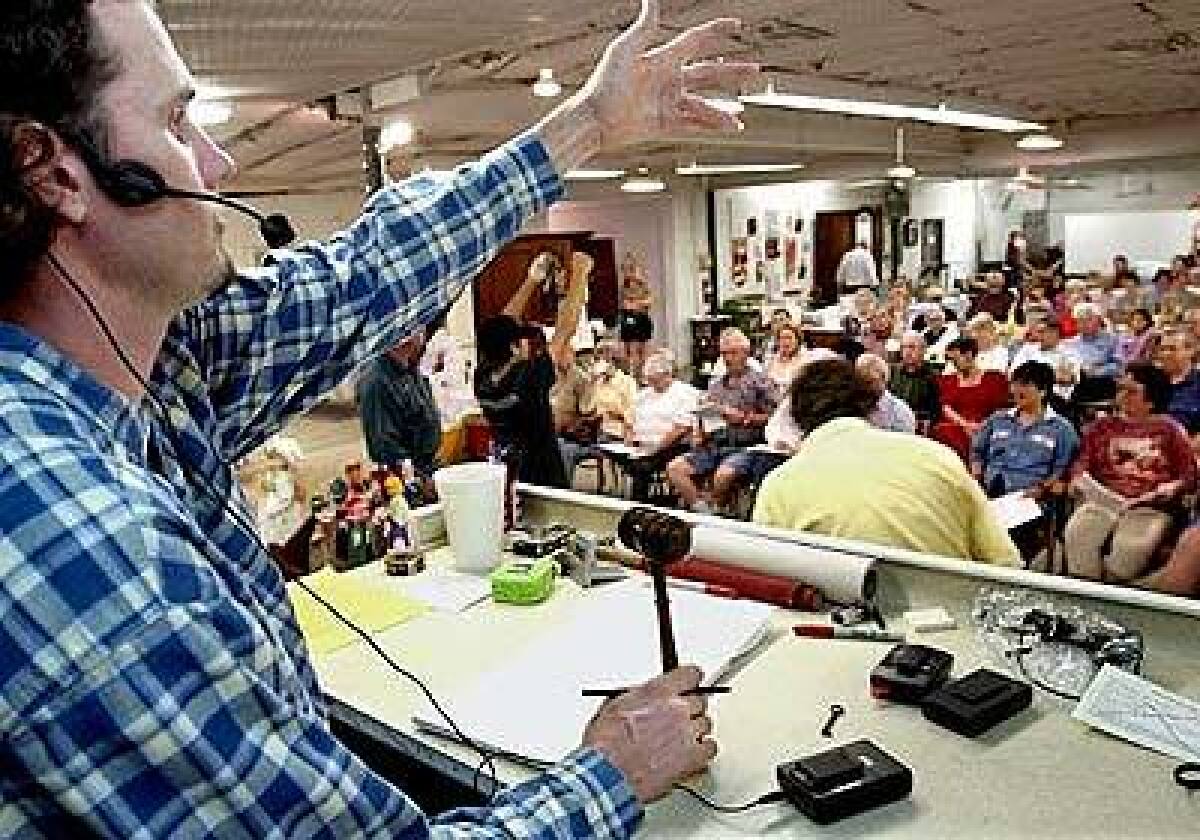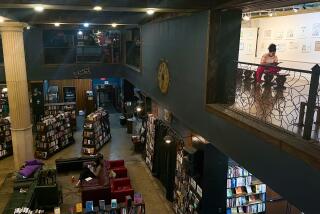Gavels fall in the Hill Country

- Share via
Thorndale, Texas — It was relentlessly muggy in the VFW Hall in Thorndale, a small town in the Hill Country northeast of Austin, where Texas melts into cornfields. Perspiration was turning into flop sweat, and my mind was wandering toward the cheap lemonade at the chili-dog stand when the man on the podium presented what appeared to be a sort of crusty spittoon.
“Can I get $12.50 for this piece of history?” the auctioneer barked.
“Yes!” shouted an assistant, spying a bid among the plastic chairs.
It surely was a sweet spittoon. You could look at it as spittoon art or as an important part of spittoon history. Either way, it had caught the eye of a gray-haired woman in the front row, who minutes earlier had bid feverishly on a box of old quilts.
“Come on, folks, take a closer look,” the auctioneer implored. “Can I get $15?”
In the back near the chili-dog stand, a man who looked as though he had stopped by on his way to a deer hunt raised his hand, prompting a bark from the assistant and a frown from Quilt Woman.
With two loud yelps and a flash of gestures, the spittoon was sold, snagged by Quilt Woman for $25. She quickly collected her prize and added it to the pile of quilts. In the back, Deer Hunter stood dejected and spittoon-less, a victim of slow reaction time and a lack of resolve.
In the small towns of Central Texas, auctions are a cutthroat form of consumer competition and far removed from the sterile world of EBay. Auctions are staged every weekend in senior centers and barns throughout the Hill Country, the rambling landscape of cedar groves and rivers surrounding Austin, San Antonio and Houston. They are uniquely Texas events, from the Frito pie, that tasty combination of corn chips and chili found in the snack bars, to the pickups in the parking lot.
In many Hill Country towns, the belongings of generations of Texans — from Texas Ranger memorabilia to French antiques — is up for grabs, attracting antiques dealers, scavenger hunters and history buffs from all over the state.
The auctions are usually announced in the classifieds section of the local papers, which is how one Saturday afternoon last fall my wife, Lietza, and I ended up driving to our first auction in Blanco, a river town equidistant to Austin and San Antonio on the Blanco River.
We headed west from Austin toward Johnson City, home to Lyndon B. Johnson’s family ranch, now a national park. The hills were lush with cedar, oak and pine trees. About 150 years ago, long before LBJ, these hills were ruled by the Comanche, who made the settlers and Apaches fear its ravines and gullies. Today the roadside is a microcosm of Central Texas. A big sign in front of a taxidermist advertised, “The Buck Stops Here.” Small shacks housing ramshackle antiques stores popped up in the middle of nowhere, their porches littered with old, rusty farm equipment.
As we approached Blanco, the hills were dominated by grand ranches, remnants of the days when cattle barons ruled. Stone pillars and rusted iron signs marked the entrance to properties with such names as the Curling H and the Rolling N; their large ranch houses were barely visible in the distance.
The centerpiece of Blanco, population 1,500, is a town square dominated by a two-story limestone building known as the courthouse. It was used as the county seat from 1886 to 1890, when, as the locals say, “LBJ’s ancestors stole” its political role for Johnson City.
With a few minutes to spare before the start of the auction, we wandered into the Blanco Flea Market, a large barn off the square. The flea market, which also bills itself as a “Historical Mohair Warehouse,” was packed with kitsch and the flotsam of rural Texas. I would have paid $325 for a 19th century carved wood pulpit, but I couldn’t fit it in the car.
Behind the counter a man with a wide gray beard strummed a guitar. “If you’re interested, every other Saturday night we have a little jam session in the back there,” he said.
Sizing us up as auction types, he shared news of an auction in nearby Twin Sisters, which shows up as a pinprick on the map.
“If you go down the road and see the big red barn, that’s it,” the man said. “But you never know when he’s going to have a sale, so you have to stop on by.”
Down the street people were already gathering at the one-room antiques warehouse for the “viewing,” the period before the auction begins where everybody can pore over the merchandise.
Many auctions have a theme — sometimes featuring the contents of containers sent from Germany or France, for example — but this one was a hodgepodge, from antique milk bottles to World War II-era English furniture.
Before the bidding started the auctioneer, a leathery cowboy with a droopy mustache, a wide-brimmed black hat and a broad silver belt buckle, moved from table to table, selling boxes filled with discarded kitchen items, old radio manuals and a thousand pieces of assorted junk, some for as little as $5.
Under a table in the back, I found a box of Life magazines from the ‘60s, including, right there on top, an issue with Mickey Mantle on the cover. Giddy with thoughts of an EBay treasure, I slid the issue to the bottom of the stack and nodded to Lietza to bid on the box.
“How about $20 for the box of magazines,” the auctioneer asked, sounding hopeful.
A woman in an old gray sweater bid $5. Lietza raised her hand for $7.50. The woman shot up her hand at $10. The action was zooming past my price range when Lietza bid $12.50, and the bidding suddenly stopped. I liked the magazines a whole lot at $7.50, but not so much at $12.50, a fear that was later confirmed when I found the Mantle issue selling for only $10 on EBay.
Right then I learned one of the most important lessons of the auction game: Know your limits.
Soon after the formal auction started, we scurried out with our Life magazines of questionable value, not yet ready for a bidding shootout in Blanco.
Auctions and barbecues
A few months later we tried again when I spotted an ad for an auction in Liberty Hill. It was about 7 p.m. and raining thick sheets with lightning on the horizon.“It’ll keep the crowds down,” I said as we raced for the car.
The road to Liberty Hill, Texas 29, led past miles of goat breeders, tractor parts stores and old churches. The main attraction of Liberty Hill, at least architecturally, appeared to be Star Burgers, a fast-food restaurant built in the shape of a star painted bright blue.
Following Texas tradition, we stopped for barbecue, pulling into the dirt parking lot of Mike’s Barnyard Barbecue, which featured plastic chairs, a roll of paper towels on each table and the obligatory plastic clock shaped like Texas hanging on a wall. It was already filling up on a Saturday night, and the sweet smell of the sauces filled the small room. We grazed on a half-pound of ribs and the brisket plate and left with our arteries sighing with joy.
The auction was another mile down the road, in an antiques store in a small strip mall. As it turned out, the rain hadn’t kept the crowds away. The plastic chairs filled up quickly, and we had only a few minutes to inspect the items, which seemed to feature a variety of deer-related objects — antler clocks, antler hat racks, antler decorating items.
Behind me a man with a belt buckle the size of a warrior’s shield nudged the woman next to him and said, “I want that flag,” nodding toward a full-sized American flag emblazoned with John Wayne’s image.
At first the crowd seemed wary. The auctioneer was a drill sergeant with a buzz cut and a surly demeanor.
“I can’t read your mind. You have to bid,” he said, chastising the crowd.
He presented each item with a bit of a wink, an understanding that the description might be several parts Texas hokum. “It looks like Limoges,” he said, eyeing a piece of glass that looked more like Le Sears.
Lietza homed in on an old signed etching of a harbor scene in a 4-foot silver frame, casually leaning against a table in the back. When it was brought to the front of the room, no one seemed interested. The bidding started at $20, but one other halfhearted competitor fell out at $25. Lietza, who bagged it for $30, held the glimmer of a wicked smile.
“I can get $300 for it easy,” she said, cradling the engraving, which, it turned out, was an 1890 work by Ernest C. Rost, described on AskART.com as an “artist, pioneer, photojournalist, adventurer and botanist.”
Later, after parking our prize on the back seat, we explored Liberty Hill. As the rain poured, we made a left off the main highway and stumbled onto the center of town, a ghost of the Old West with two rows of white stone buildings and creaky wood storefronts, some still with hitching posts.
In the 1800s, Liberty Hill was home to the only post office in the area, making it an important spot for local commerce.
The one that got away
Inspired by Lietza’s success, I searched the Thursday and Friday newspapers the next few weeks for auctions. Each week they popped up in such towns as Davilla and Bartlett, names that confounded the Mapquest Web site.One ad promised a Sunday afternoon auction in Breham, which, Mapquest assured me, was just east of Eden, Texas. But there was a typo in the ad. The town’s name was Brenham, which, I learned, is nowhere near Eden.
Lietza couldn’t go, but I was bored and eager for a drive. So on a crystal clear Sunday morning, I drove east from Austin on U.S. 290 to Brenham. As I passed through the long stretches of green fields, road signs offered tantalizing detours, from the “historic cotton gin” in Burton and Elgin, “home of the famous Elgin hot sausage,” to clusters of roadside antiques stores in Giddings and Washington-on-the-Brazos, birthplace of Texas.
Brenham, it turned out, is no one-stoplight town. It is a key crossroads northwest of Houston, containing rows of three-story Victorian mansions and a massive Art Deco courthouse. Besides the bluebonnets and wildflowers that color the hills each spring, a top attraction here is the Brenham Brewery, whose slogan is, “They died at the Alamo so we can drink Texas beer.”
It was a slow drive, so I showed up three hours after the scheduled start of the auction. But it looked as though it was just cranking up.
In contrast to the machine-gun patter of his peers, this auctioneer was a kindly uncle with a rolling drawl.
“In New Orleans these will bring $500,” he said, pointing to two leather chairs that sold for $75 each.
Bids were flying.
A boxing ring bell sold for $80. “Very rare,” the auctioneer said.
Pipes shaped like old Western revolvers sold for $30 apiece. “Never seen anything quite like these,” the auctioneer said.
A woman in a red turtleneck snagged an Oriental rug for $125. “Yes! I wanted that rug,” she said, pumping her fist.
On my own and determined to participate, I focused on a metal Victorian table described as a vase stand. I envisioned it as a place to toss the mail.
“Let’s start at $200,” the auctioneer said, sending a knife through my heart. I had set my ceiling at $30.
But when no one took the bait, the bidding started at $25. Two other bidders chimed in, forcing me to reconsider the need for a monofunctional Victorian table. While I mulled over a $50 bid, the mail stand of my dreams sold for $60.
I was crushed but reminded myself that auctions are all about discipline and focus. Then, to ease my disappointment, I headed to the snack stand for a taco.
More to Read
Sign up for The Wild
We’ll help you find the best places to hike, bike and run, as well as the perfect silent spots for meditation and yoga.
You may occasionally receive promotional content from the Los Angeles Times.






